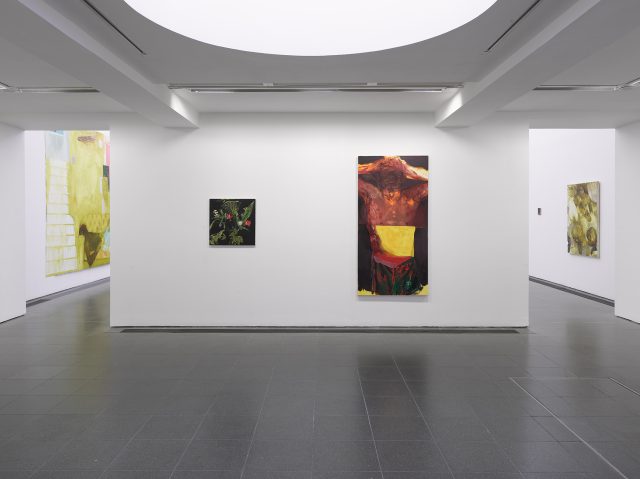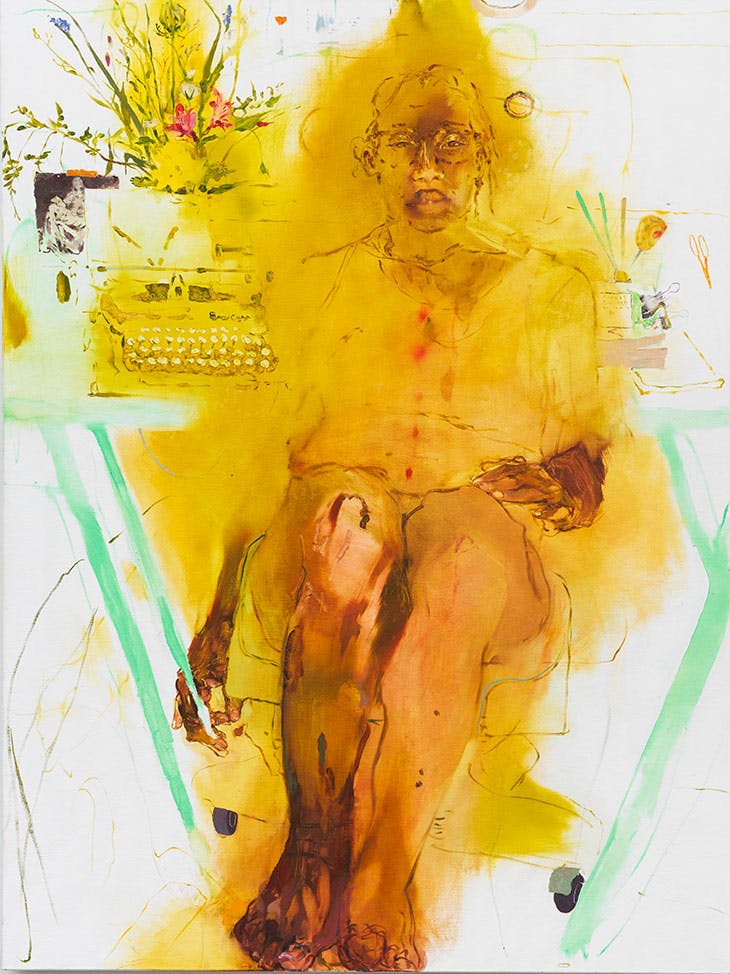
April Restless, 2017, Oil on canvas, Private Collection. Courtesy the Artist, Corvi-Mora, London and Sikkema Jenkins & Co, New York, Photo: Marcus Leith.
A sketch of a woman centers the painting. This sketch is then painted over with various shades of black, brown, and yellow. A typewriter, a small square print of Michelangelo’s Pietà, and a bold arrangement of flowers sit behind the woman. She stares directly at the viewer; her expression neutral. On her chest, drips of neon pink paint form a faint line leading towards her abdomen.
There is a lot to unpack in this painting titled “April Restless” (2017), dedicated to Jennifer Packer’s poet friend April Freely. We see the subject at her workplace, a setting in which she feels the most confident—evidenced by her gaze—and the most vulnerable—evidenced by the wound on her chest. We see the irony in how the subject is sitting perfectly still, despite being marked as “restless.” We see the reference to the canon of art history, in spite of the fact that the canon often excludes people like Packer or Freely. Most importantly, we see a celebration of life (flowers), art (Pietà), creation (typewriter), and Blackness.
Jennifer Packer’s exhibition at the Serpentine is her first outside the US, which is somewhat startling considering her remarkable resume. In the US she is represented by Sikkema Jenkins & Co, and she participated in the 2019 Whitney Biennial. This year she won the Rome Prize at the American Academy in Rome. In addition to her artistic career, she is an Associate Professor at the Rhode Island School of Design.
Art historically speaking, her works fall under two traditional genres of painting: portraiture and still life. The subjects of each portrait are Black figures close to Packer personally. These portraits feel intimate, often depicting their subjects in domestic settings. The still lives depict sprouting plants and flowers in warm colors. They ooze with vitality. Throughout the exhibition, both genres are in dialogue, forming an unlikely grouping. They are oftentimes hung facing each other, and Packer uses similar color palettes in each.
When the two genres of paintings are viewed in relation to each other, their effects on the viewer meld. Slowly, the portraits start resembling the still lives. In the fictocritical work Ordinary Affects (2007), Kathleen Stewart defines the still life as “a static state filled with vibratory motion, or resonance.” According to Stewart, still life works give the quotidian the chance to “unfold.”[1] We observe this unfolding in Packer’s paintings: intimate, cozy scenes of home life turn into majestic statements of Blackness, power, and vulnerability. There is something political about how dynamic these paintings are and how they challenge the conventions of portraiture painting. The paintings actively diverge from the authority and rigidness associated with classical portraiture.
 Say Her Name, 2017, Oil on canvas, 121.9 x 101.6 cm 48 x 40 inches Private Collection. Courtesy the Artist, Corvi-Mora, London and Sikkema Jenkins & Co, New York, Photo: Matt Grubb.
Say Her Name, 2017, Oil on canvas, 121.9 x 101.6 cm 48 x 40 inches Private Collection. Courtesy the Artist, Corvi-Mora, London and Sikkema Jenkins & Co, New York, Photo: Matt Grubb.
Contemporary artists, particularly Black ones, have redefined portraiture paintings over the recent years. Artists like Kerry James Marshall and Lynette Yiadom-Boakye bring a fresh perspective to a genre that is historically associated with power, class, racism, and misogyny. Packer’s innovation, in addition to its political immediacy, is also formalist. Her expert use of colors, particularly her greens, oranges, and yellows, is admirable. Her amalgamation of sketch and brushwork, as well as her use of scale, is equally commanding. Overall, Packer’s works inform us about the current state of painting, and what its future may hold.
[1] Kathleen Stewart, Ordinary Affects (North Carolina: Duke University Press, 2007), 19.
Jennifer Packer: The Eye Is Not Satisfied With Seeing



 Say Her Name, 2017, Oil on canvas, 121.9 x 101.6 cm 48 x 40 inches Private Collection. Courtesy the Artist, Corvi-Mora, London and Sikkema Jenkins & Co, New York, Photo: Matt Grubb.
Say Her Name, 2017, Oil on canvas, 121.9 x 101.6 cm 48 x 40 inches Private Collection. Courtesy the Artist, Corvi-Mora, London and Sikkema Jenkins & Co, New York, Photo: Matt Grubb.